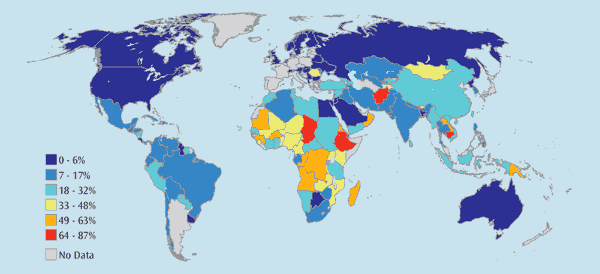A friend of mine has been asked to design a small scale UV-light water purification system for use in the developing world, and he called me to ask what I knew about getting machines to work in poor places. At first I didn’t know what to say to him, because he’s at least as good an engineer as I am, but as the conversation continued I began to discover what he was missing. Engineering is the easy part of getting technology into the developing world. Getting technology accepted, used, maintained, and paid for is the hard part.
Clean drinking water has been ubiquitous and cheap in the developed for so long that everyone has forgotten what an accomplishment it actually is. In reality, many of the countries in the world do not have such infrastructure. The Water Sanitation and Health section of the World Health Organization estimates in a 2006 report that 1.1billion people are currently without “improved” (cleaned) drinking water. A map of the percentage of the population of each country without access to safe drinking water shows this clearly:

(Image and data from theglobaleducationproject.org.)
Drinking or bathing in biologically contaminated water — say, from a river that the villagers upstream defecate into every morning — causes serious disease epidemics. It seems ridiculous that large numbers of people will die this year from diarrhea, but they will. All the travel guides tell us not to drink the local water, but the locals have no choice.
So a village-scale UV water disinfection system seems like a great idea. Such a system kills pathogens by exposing water to strong ultra-violet light from a special bulb. It’s cheap, simple, reliable technology. One can imagine building the device out of rugged materials, and just for good measure powering the whole device with solar cells. Hand it off to the grateful villagers, count yourself lucky to have been able to help, and go home smiling. But it wouldn’t work.
What happens when the bulb needs to be changed? Where do you get a new one? From whom? Who pays for it? What about maintenance generally? Who is trained to repair such a thing? With what materials? Why would they bother repairing it at all? Does the designated repair person actually appreciate the link between dirty water and disease? Does the community? Is the machine going to be cannibalized for useful parts such as batteries? Who is responsible for running it? Will it rust in the monsoon rains/corrode in the the desert dust/rot in the the jungle damp?
We in the developed world may see that water purifier as a simple machine, but in reality it is a machine that is supported by a vast network of infrastructure and institutions. Any developed country can easily manufacture the needed parts — light bulbs and pumps, basically — and further, has a vast educated workforce of persons who already know how to use a screwdriver. In rural Africa, the population may be mostly illiterate and is certainly mostly uneducated, and probably has very little in the way of tools — as a reference point, I noticed that the typical rural household kitchen in Mali contains exactly one big bowl, one wooden spoon, and one rusty knife. Even more crucially, a water purification machine relies completely on the idea that clean water is important. A village of very poor people who were never taught the germ theory of disease in elementary school probably do not see water disinfection as a priority.
There can be even more fundamental misunderstandings of world-view on the part of those who wish to help. In order to actively participate in a water purification project, the target population must first believe that change is possible through their own efforts. In our hyper-entrepreneurial society, it can be difficult to understand how dis-empowered the members of certain societies, cultures, or social groups feel. Sometimes this is even justified through religious fatalism: we will have clean water, if Allah wills it.
I do not have many ideas about how to deal with such dis-empowerment. What I can do is point to a few developing world technology projects that seem to be successful at the village level. For example, a foot-powered water pump sold throughout sub-Saharan Africa, as advertised in this signboard from Mopti, Mali:
The “Moneymaker” pump is a product of KickStart, a non-profit dedicated to the “tools to end poverty.” It is simple, robust, and specifically designed to be manufactured in Africa; KickStart even trains the manufacturers. The pump also appeals to a need that needs no explanation in the local culture: the opportunity to make money by growing and selling vegetables. Public health will be harder to promote; it will require far more than good technology.
Great oaks from little acorns grow.